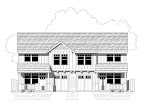Dr. Istockhouseplans answers your questions about studs.
"Dr., I'm not comfortable placing my studs at 24" o.c. Won't the wall fall down?"
No, as a matter of fact, it won't. Satisfying the seismic and wind requirements is the job of the sheathing, not the studs. The studs take the direct downward weight of the house and give you something to attach your sheathing to. The sheathing needs to be able to withstand the wind and movement. If you think about a SIPS panel, how many studs are there inside? None. How much sheathing is there? On every wall. 24" o.c. spacing also allows for more insulation inside the walls.
"But doesn't 24" o.c. studs cause wavy walls?"
Again, no. Wavy walls are caused by you not allowing 1/8"* between your sheathing panels. When you butt that OSB right up against each other, where does it go when it gets wet and expands? Out to the sides? No, the panels push against each other and buckle at every 4' increment. This causes the wavy look. Space your sheathing panels per manufacturer's recommendation. Scroll down to read item #1 on extremehowto.com. (*please read the sheathing for the proper spacing).
"What about my drywall, won't it break if someone pushes on it?"
If you are installing drywall horizontally against the studs you shouldn't have any problem at all. If it concerns you then you can bump up to 5/8" sheetrock instead of 1/2" but keep in mind that the code allows 1/2" gyp on a 24" o.c. wall.
"But all my savings from the studs will be eaten up by having to buy 5/8" sheetrock. What's the point?
The point is that even if the wall costs you the same (which if it is then your drywaller is upcharging you quite a bit - shop around), you have built a better wall which will differentiate yourself from all the other builders out there. Your wall will be more insulated and save your homebuyer in energy bills. Saving energy is good for the environment. Saving the environment makes you look like a hero.
"I don't think the code will let me build a wall like that."
Please stop the excuses. We wouldn't be encouraging you to do something illegal. If you have an IRC code book handy, open up to 602.3.1 (page 123) and reference table 602.3(5) (page 127). You'll note that a 2x6 wall with studs spaced 24" o.c. is allowed to support a second story, ceiling, and roof AND be 10' tall. How about that? Granted, a 3 story home will need 16" o.c. spacing on the first floor, but you can still use 24" o.c. spacing for floors two and three. Also note how interior non-bearing walls may be built with 2x3 studs at 24" o.c. Understandably this is not a good idea for walls with doors in them unless you do fat trim work or build your own frames.
"I still don't think it's a good idea."
Well that's your issue. We can't make you do anything, only educate you as much as possible. If you don't want to then be prepared to be left in the dust by builders whose homes sell quicker and cost them less to build. But don't say we didn't warn you. If you have any further questions or concerns please feel free to contact us. Stay tuned next time for floor issues.
Tuesday, June 3, 2008
Subscribe to:
Post Comments (Atom)






No comments:
Post a Comment